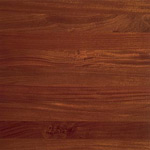For a quicker response, please send all inquiries
via info@canfloor.com or
text to
416-735-0075.
| Monday - Friday | 10:00 am - 7:00 pm |
| Saturday & Sunday | 10:30 am - 4:00 pm |

Scientific Name: Myroxylon balsamum
Other Names and Species: Balsamo, Cabriuva Vermelha, Cedro Chino, Chirraca, Estoraque, Incienso, Nabal, Navo, Palo de Balsamo, Quina, Sandalo, Tache, Tolu
Origin: Wide distribution, from southern Mexico southward through Central America down to Argentina.
Appearance: The very fine and even texture of this well-known and popular hardwood, along with its striped figuring, complements the attractive dark reddish brown color of mahogany wood flooring. The white sapwood is sharply demarcated from the heartwood. The grain of mahogany is typically interlocked, and the surface can have a medium to high luster. When freshly cut, it has a pleasant spicy scent.
Properties: Mahogany is known for its strength and beauty, and it has outstanding durability. Given its hardness and color-fastness, santos mahogany is a superior choice to genuine Honduran mahogany (Swietenia macrophylla), which it closely resembles in color. In fact, although genuine mahogany is traditionally chosen for fine furniture and millwork, it is seldom used in wood flooring because it lacks sufficient hardness to withstand constant foot traffic.
Workability: Because of its hardness, which can make sawing and machining difficult, carbide tooling is recommended for santos mahogany wood flooring. It sands beautifully to a high natural polish, however, and has good holding ability.
Principal Uses: Mahogany is typically found in wood flooring, turnery, interior trim, and furniture. The pleasantly aromatic balsam of santos mahogany is often used as an ingredient in some perfumes.
